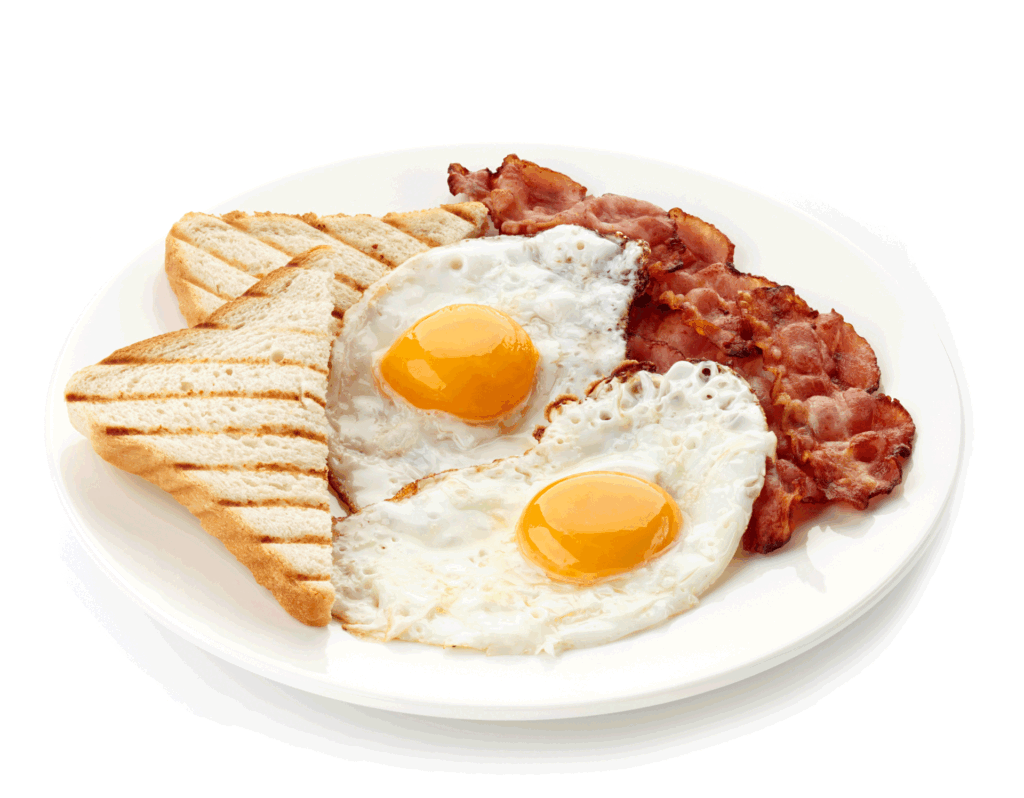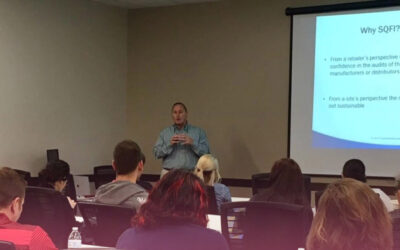By Gary C. Smith, Colorado State University
Are Manufacturers of Sugary Products Running Out of Marketing Options?
Things are going great for manufacturers of sweets, sugary foods/beverages, ultra-processed foods, and foods with high levels of refined carbohydrates. Consumers are addicted to their products – we love the stuff!1,2 It’s the marketers of these products that are running out of options. Manufacturers of these products certainly have the right to make them, and to try to sell more of it.3,4 That’s not at question; the question is how, and to whom, they market it.
How Did Dietary Guidelines Impact Traditional Breakfast Choices?
The low overall fat, no saturated fat, low-cholesterol, low-sodium, low-sugar guidance of the 1980 Dietary Guidelines For Americans (DGFA) annihilated the conventional breakfast meal. To comply with DGFA, people had to trade-off eggs and buttered biscuits, toast, pancakes, and waffles as well as bacon, ham, and pork sausage for rice, oatmeal, gruel, or porridge – but with limited added sugars. The absence of fat and the satiety it provides, made people hungry again – long before noon – so they ate snacks.

Indigenous Dietary Habits May Have Held a Clue Missed by Modern Guidelines
The “experts” on the Advisory Committee of the DGFA failed to recognize that the Indigenous People of North America fought tooth-and-nail for the fatty parts of seals, fish, game animals, and especially the American Bison – oft times leaving the muscular parts for other carnivores because the people wanted and needed the satiety and nutrients associated with the organs and adipose tissue.5-7 Those people almost never became obese or died from diabetes or heart disease.5-7 And, other than robbing honey from bee hives, they had no access to sugars per se.
Why Did AHA’s Dietary Recommendations Shift Toward Sugar and Carbohydrates?
As early as 1968, the American Heart Association (AHA) warned against reducing fat in the diet because that would lead to excessive consumption of refined carbohydrates, sugary beverages, and sweets.7 Mysteriously, in 1970, АНАpivoted and started releasing pamphlets telling Americans to reduce their fat intake yet achieve satiety by choosing snacks, refined carbohydrates, and sweets.8 The National Institutes of Health (NIH) criticized AHA for telling Americans to cut back on total fat when there was no evidence to support such reduction and no evidence to support consuming more refined carbohydrates or added sugar9 – but to no avail.
How Did the 1980 DGFA Influence Breakfast Cereal Manufacturers?
As a result of the AHA’s reasoning and its pamphlets, manufacturers of breakfast cereal prospered for the decade of 1970 to 1980 – they were providing the refined carbohydrates and sugar that people needed to replace the devil’s foods (meat, poultry, egg, and dairy products). Then came the 1980 DGFA advising men, women, boys, and girls to “use sparingly” fats, oils, sweets, and added sugars.10 Children should avoid sugar? That’s who Big Cereal markets to. Big Cereal’s counter-attack was to double-down on its support of AHA and its lobbying of FDA.
AHA Benefits from Promoting Refined Carbohydrates
AHA had steered Americans toward sugar as the solution for not eating animal-based foods.11,12 AHA then rode the profit wave of refined carbohydrates from the 1990s onward by charging a hefty fee for the privilege of putting the AHA’s “Heart Healthy” Check Mark with the label ending up on some dubious candidates such as Kellogg’s Frosted Flakes®, Fruity Marshmallow Krispies®, and Pop Tarts®12 In 2012, it was on Honey Nut Cheerios® and Quaker Life Cereal Maple and Brown Sugar®7, and, in 2023, “Heart Healthy” was on Walmart Great Value Frosted Bite Sized Shredded Wheat® and Quaker Simply Granola, Honey & Almonds® – in my pantry. Given the AHA’s role in promoting high-sugar foods, it therefore seems disingenuous to blame the food industry for the shift from fat to refined carbohydrates and sugars.12,13
What Impact Did the NLEA of 1990 Have on Food Labeling?
Prior to 1990, putting a heath claim on a food label was prohibited. Kellogg’s™ wanted to make claims about diet and health on their cereal boxes; so, the U.S. Congress passed the Nutrition Labeling and Education Act (NLEA) of 1990.14 Big Cereal’s “knock out punch” logic was that FDA would never allow the word “Healthy” to be associated with the competition (i.e., butter, eggs, sausage, ham, and bacon) because they contain too much fat, saturated fat, and/or cholesterol. Nevertheless, FDA has struggled – for 33 years – with what is considered “Healthy” food, and what can be legally labeled as “Healthy”.15,16
NLEA gave FDA the right to regulate food labels (21 CFR 10), which includes:
- Nutrient Content Claims (21 CFR 101.13) to characterize the level of a specific nutrient (e.g., “Low In Fat Content”).
- Health Claims (21 CFR 101.14) must name the food substance and the disease or health-related condition (e.g., “Heart Healthy: Diets rich in whole-grain foods and other plant foods and low in saturated fat and cholesterol may help reduce the risk of heart disease”).
- Use Of The Word “Healthy” (21 CFR 101.65). Use of a statement that suggests that a food, because of its nutrient content, may help consumers maintain healthy dietary practices.17
From 1990 to 2022, FDA approved 12 “food-ingredient-health connection” claims and 30 “qualified health claims”, depending largely on DGFA ideology.14,18
How Are Breakfast Cereals Currently Advertised and Labeled?
Some breakfast cereals have front-of-package (FOP), principle-display-panel (PDP) verbiage on their boxes and use messaging for advertisements and marketing based on 21 CFR 10. Some who make Nutrient Content Claims using descriptors (e.g., “Excellent source of”; “Low In”) or actual amounts (“42 grams of”; “Less than 3 grams of”) of whole grains, fiber, vitamins, minerals, or cholesterol include Post Sweet Dreams®, Walmart Crunchy Honey Oats®, Walmart Strawberry Awake®, General Mills Cheerios Oat Crumbles®, and Kellogg’s Frosted Flakes®. Some make Heart Healthy claims – Walmart Frosted Shredded Wheat®, Kellogg’s Raisin Bran®, General Mills Honey Nut Cheerios®, Walmart Crunchy Raisin Bran®, Quaker Simply Granola®, General Mills Cheerios®, and Quaker Life Multigrain®. Some make no Nutrient Content or Health claims – General Mills Lucky Charms®, General Mills Trix®, Post Honey Bunches of Oats®, and General Mills Cinnamon Toast Crunch®.

Is the AHA’s “Heart Healthy” Checkmark Misleading?
Things are happening that involve AHA, FDA, DGFA, NIH, the White House, Tufts University, and the research community that will affect the future of breakfast cereal. My frame of reference is based on information garnered from 24 boxes of Post™, Kellogg’s™, General Mills™, Walmart™, and Quaker™ cereals.
AHA is currently facing a lawsuit over its failure to disclose to consumers that food companies can pay a fee to use the Heart Healthy Checkmark shield on their food packages, and not requiring use of its own nutritional and scientific guidelines in determining if a product is truly “Heart Healthy”.19 AHA doesn’t appear to be a major player in this space. All five manufacturers have one or more products with a FOP claim of Heart Healthy but only one of the seven cereals (i.e., General Mills Cheerios®) uses the AHA Checkmark shield – the others use the FDA version of Heart Healthy.
FDA Proposes Updates to the “Healthy” Claim Criteria on Food Packaging
FDA proposed a rule on September 28, 2022 to update the definition of the “Healthy” claim (21 CFR 101.65) on food packaging that:
- Relies on DGFA and current Recommended Daily Allowances of certain nutrients, and
- Uses a food-group-based approach in addition to “nutrients to limit” (those are saturated fat, sodium, and added sugars).20
On March 29, 2023, FDA issued “Dietary Guidance Statements In Food Labeling”, saying, “All these claims (Nutrient Content, Health, and Dietary Guidance Statements), must support DGFA 2020-2025 recommendations if they are to be used on a product’s Principle Display Panel or to be used in any other marketing materials.21 In order for a food product to bear a Dietary Guidance Statement (DGS) or any DGS symbol or vignette, the products must not exceed certain nutrient levels that are inconsistent with a healthy dietary pattern (i.e., it must have a Percent Daily Value of less than 10 for each of saturated fat, sodium, and added sugars).21,22
Relative to what the FDA has proposed for Percent Daily Values (%DVs)…
- All 24 of my reference cereals passed muster on the “less than 10%” limit for saturated fat (they range from 0% to 5%).
- 18 of 24 cereals had “less than 10% for sodium (they range from 0% to 13%).
- Only 4 of 24 cereals had “less than 10%” for added sugars (they range from 2% to 32%).
So, it’s “game over” for 22 of my reference cereals if FDA uses dry cereal as the basis for approval to use a DGS; only General Mills Cheerios® and Kellogg’s Rice Krispies® at “less than 10% DVs” for all three “nutrients to limit” (i.e., saturated fat, sodium, added sugars) clear that hurdle.
Several cereal boxes provide % DVs in the Nutrition Facts panel for dry cereal plus ½ or ¾ cup of skim milk. With that, the serving’s % DVs for saturated fat go up by 0% to 3% and for sodium go up by 2% to 3%. As a result, all 24 of the cereals – including General Mills Cheerios® and Kellogg’s Rice Krispies® – lose eligibility for a DGS.
What Are the Nutrient Restrictions for Children’s Cereals According to DGFA?
But what does DGFA really say about nutrients to be restricted in children’s diets? With one exception (i.e., General Mills Cheerios®), the % DVs in the Nutrition Facts panels on cereal boxes are based on serving sizes (i.e., the Reference Amount Customarily Consumed – RACC – to achieve an intake of 2,000 calories per day) for adults. DGFA recommends no saturated fat and no added sugars for a child less than 2 YOA, as well as diminished serving sizes (i.e., 52%, 65%, and 78% of adult RACC) for children of ages 1 through 3, 4 through 8, and 9 through 13 years, respectively.22
With that, children less than 2 YOA shouldn’t eat any of the 24 cereals, and children 3 to 14 YOA should only eat limited servings of two of the 24 cereals (i.e., General Mills Cheerios® and Kellogg’s Rice Krispies®). A study in The Annals of Nutrition and Metabolism said early exposure to sugar may discourage children from liking non-sweetened foods and thereby increase the risk of obesity later in life.23
Is There a Hidden Influence Behind DGFA Recommendations?
The DGFA 2020-2025 Advisory Committee wanted to recommend 6% (down from 10%) of calories from added sugars but eventually did not;24 some believe that’s evidence of meddling by the Deep State and/or lobbyists (by “Big Sugar”, “Big Food”, NIH, or AHA).25,26 Since then, results of new research studies published in JAMA Internal Medicine, Circulation, and British Medical Journal have identified “added sugars” as being a major culprit in up to 45 negative healthy outcomes.27-31
How Important Are Nutrition Facts and Ingredients for Consumers?
Consumers believe that the Nutrition Facts panel is more important in determining “Healthfulness” than is the Ingredient List.32 “Sugar” ranks at the top of what adults look for (at 56%);33 the three nutrients that most Americans say they “need less of” are:
- Saturated fat
- Sodium
- Added sugars34
In 2022, FDA updated the Nutrition Facts panel by requiring that “Added Sugars” be added because “consuming too much added sugars can make it hard to meet nutrient needs while staying within calories limits”.35 MyPlate® says, “A healthy dietary pattern doesn’t have much room for added sugars… foods and beverages high in these components should be limited”.36
Is There a Need for Front-of-Package Warning Symbols?
FDA has considered using the Food Labeling Modernization Act of 2021 to require that a FOP “Warning Symbol” be placed on food products that are high in saturated fat, trans fat, sodium, added sugars, and any other negative nutrients.37
Health Canada just mandated a new FOP nutrition system for packaged foods that contain nutrients of public health concern at or above specified thresholds.38 The FOP Symbol is a “Warning Label” that will help Canadians avoid excessive consumption of foods that are unhealthful”.38 The Warning Symbol must appear when the amount of saturated fat, sodium, and/or sugars is at or above 10% of the applicable Daily Value.38 If U.S. manufacturers sell products in Canada, the products must comply with Canada’s mandate.38
What Will the Advisory Committee for DGFA 2025-2030 Focus On?
The Advisory Committee for DGFA 2025-2030 has announced it will examine “Topics most often raised in Public Comments”, which include:
- Healthy eating
- The gastro-intestinal microbiome
- Ultra-processed foods
- Low-carb diets39-42
Breakfast cereals are both ultra-processed and high-carbohydrate foods, so things could get worse. The NOVA food classification system defines ultra-processed as “any product with more than five ingredients”; 40 others say the term means food with a high proportion of artificial and/or added ingredients.43
How Are Ultra-Processed Foods Impacting Health in America?
NIH has concluded that ultra-processed foods are playing a big role in America’s ever-expanding waistlines.44 Epidemiological studies, clinical trials, and scientific opinions have concluded that overconsumption (too much or too frequent) of ultra-processed food causes people to consume excess calories, gain weight, become obese, and have increased risk of high blood pressure, heart and circulation problems, cognitive impairment, dementia, Alzheimer’s disease, diabetes, cancer, and shorter lifespan.27,42-53
Do We Misunderstand the Term “Ingredient”?
The meaning of the term “Ingredient” on cereal boxes is unclear. Just below the Nutrition Facts panel, there are “Ingredients” (the reference cereals have 4 to 27 items in their lists); beneath that, there are “Vitamins and Minerals” (the reference cereals have 0 to 13 items in their lists). Combined, there are 7 (Kellogg’s Raisin Bran®) to 38 (Kellogg’s Special K) total Ingredients in these cereals. General Mills Kix® has a FOP claim of “Just 7 Ingredients + Vitamins & Minerals.” So, if Vitamins and Minerals don’t count, five cereals have only four Ingredients and thereby escape demonization as being ultra-processed (i.e., four from Kellogg’s – Rice Krispies®, All-Bran®, Corn Flakes®, and Frosted Flakes® – and one from Walmart™ – Frosted Shredded Wheat®).
Is Ultra-Processed Food Inherently Bad or Is It About Consumption Patterns?
In truth, there is no scientific evidence that there is anything in ultra-processed food that is dangerous, it’s the fact that we eat too much when we do eat it.54 Ultra-processed foods propel people to overeat – and they gain weight.42 Too much ultra-processed food in your diet leads to obesity, Type 2 diabetes, heart disease, and cancer; we’ve gone too far inasmuch as it also leads to hypertension and premature death.42 Brazil, Peru, and Uruguay have dietary guidelines that specifically recommend freshly prepared meals and avoiding ultra-processed foods.42 Avoiding – not eliminating – is a much less draconian approach to offering advice on public heath.
How Is Advertising Influencing Eating Habits?
Ultra-processed foods currently make-up nearly 60% of what the typical adult eats, and nearly 70% of what kids eat.55 An old adage is, “When I was growing up, my mother’s menu consisted of two choices – take it or leave it.”56 One in five U.S. parents say they are often too stressed to cook and 88% say they let their children pick what they want to eat.57 Companies and brands use “consumer segmentation” to develop marketing strategies and tactics that are narrowly aimed at identifiable groups of consumers and offer solutions to specific needs or pain points.58 People’s eating habits are largely mediated by factors outside their conscious control – chief among the factors that cause “craving” are food advertisements and commercials on billboards, cell phones, and television.59
Are Children Being Exposed to Unhealthy Influences Online?
A Pediatrics study of “influencers” (usually children themselves) on YouTube who were pushing unhealthy food to children, found that they were “host selling” (where hosts or characters of a television show promote products within that show).60 Researchers are calling for federal regulations limiting such exposure of children in that “host selling” is banned from broadcast television.60
Health Canada’s Food & Drug Regulations agency intends to restrict “advertising to children” of foods (including “sweetened breakfast foods”) that contribute to excess intakes of sodium, sugars, and saturated fats.61 USDA presently offers $1 million grants to State Agencies and School Food Authorities that agree to teach MyPlate® nutrition courses to school-aged children (Pre-K through 12) and their families.62 It is tragic that our federal government would bribe educators to brainwash children with nutrition advice that has led Americans to a 3-fold increase in obesity, an 11-fold increase in diabetes, and no demonstrable effect on incidence of heart disease or cancer.
What’s the Future for Breakfast Cereals and Marketing Strategies?
Things look bleak for manufacturers of sweets, sugary foods/beverages, ultra-processed foods, and foods with too much refined carbohydrates. It does not appear likely that the FDA will allow breakfast cereals to bear a “Healthy” label claim. Marketers of such products are running out of options. That’s not keeping them from trying.
Post Sweet Dreams® is being marketed – not as a breakfast cereal – but as “Part of a healthy sleep-routine cereal” that supports natural melatonin production. Some breakfast-cereal manufacturers feature arrays of “any-time-of-day” (not just breakfast) offerings that comply with consumer’s cravings.63 Kellogg’s™ just added to its portfolio with:
- Special K Oat Crunchy Honey® for those who want crunchy foods.
- Special K High Protein®, which is fortified with soy, pea, and lentil proteins.
- Special K Zero®, which replaces “added sugars” with allulose, sucralose, and monkfruit extract.63
How is NIH Responding to the Current Food and Health Landscape?
NIH – under pressure from “Big Food” and/or “Big Sugar” – is trying to fend-off the demonization of sweets and sugary foods/beverages by the DGFA 2025-2030 and the potential attack on ultra-processed foods by the DGFA 2025-2030.64 Dariush Mozaffarian (Tufts University) used NIH funding to develop a Nutrient Profiling System (i.e., Food Compass Scores) that creates a new “Healthfulness” scale and a new Food Pyramid.65 The results are absurd; 70 breakfast cereals (led by General Mills Lucky Charms®) ranked higher on the NPS-FCS Healthfulness scale than either meat or eggs.65 Mozaffarian has lobbied for NPS-FCS as an alternative to the DGFA at the White House Conference on Hunger, Nutrition & Health, at a World Economic Forum, and to the U.S. Congress.66
Food Safety Net Services offers a full range of food testing, including chemistry testing for sugar and other compounds, as well as nutritional labeling testing services for all your testing needs.
References:
1 Turner, Jeanne. 2020. Food Processing. January Edition.
2 Volkow, Nora. 2011. National Institute on Drug Abuse. November Edition.
3 Hoyle, Tim. 2011. Bloomberg News, November 6 Issue.
4 Demetrakakes, Pan. 2021. Food Processing. September 21 Issue.
5 Hrdlicka, Ales. 1908. Smithsonian Institution Bulletin 34. Washington, DC.
6 Newcombe, W.W. 1961. University of Texas Press. Austin, TX.
7 Teicholz, Nina. 2014. The Big Fat Surprise. Simon & Schuster. New York, NY.
8 Stamler, J. and H. Epstein. 1972. Preventive Medicine 1: 27-48.
9 Frederickson, Donald. 1971. British Medical Journal 2: 187-192.
10 USDA-USDHHS. 1980. Dietary Guidelines For Americans. Washington, DC.
11 Baum et al. 2012. Journal of Clinical Lipidology 6:216-234.
12 Rothstein, William. 2003. Rochester Studies In Medical History. University of Rochester Press. New York, NY.
13 American Heart Association. 1995. An Eating Plan For Healthy Americans. Dallas, TX.
14 Avis, Ed. 2022. Food Processing. June Edition.
15 Malcolm, Hadley. 2016. USDA Today. May 12 Issue.
16 Food Processing. 2020. April Edition.
17 FDA. 2023. usfda@public.govdelivery.com. Accessed 7/14/2023.
18 Stevens, S. and E. Presnell. 2022. Food Quality & Safety. May Edition.
19 Scott, Chris. 2022. Meatingplace. September 7 Issue.
20 Fusaro, Dave. 2022. Food Processing. October Edition.
21 FDA. 2023. EAS Consulting Group. March 29 Issue.
22 USDA-USDHHS. 2020. Dietary Guidelines For Americans. Washington, DC.
23 CHI St. Joseph Health. 2019. Refresh: Medical Issue. Winter Edition.
24 Fusaro Dave. 2020. Food Processing. August Edition.
25 Teicholz, Nina. 2022. Meatingplace. October 28 Issue.
26 Dittmer, Steve. 2020. AFF Sentinel. August 12 Issue.
27 Shangguan et al. 2021. Circulation. September Edition.
28 LaMotte, Sandee. 2023. CNN. January 9 Issue.
29 Processed Foods. 2023. AG·WEB. February 15 Issue.
30 Huang et al. 2023. British Medical Journal 381:e071609.
31 Rogers, Kristen. 2023. CNN. April 5 Issue.
32 Sollid, Kris. 2020. Food Technology. December Edition.
33 NPD Group. 2021. Food Processing. October 26 Issue.
34 Demetrakakes, Pan. 2022. Food Processing. July 27 Issue.
35 FDA. 2023. fda.gov. Accessed 4/1/2023.
36 USDA. 2023. MyPlate.gov. Accessed 6/30/2023.
37 Fusaro, Dave. 2021. Food Processing. September Edition.
38 Health Canada. 2023. Government of Canada. May 16 Issue.
39 Kelly, Susan. 2022. Meatingplace. April 15 Issue.
40 Keefe, Lisa. 2022. Alt·Meat. February Edition.
41 USDA-USDHHS. 2023. DietaryGuidelines.gov. Accessed 7/19/2023.
42 Gardner, Christopher. 2023. Stanford University. May 25 Issue.
43 Demetrakakes, Pan. 2021. Food Processing. August 10 Issue.
44 Boudreau, Catherine. 2019. Morning Agriculture. May 17 Issue.
45 Hall, Kevin. 2019. National Institutes of Health. May 17 Issue.
46 Godoy, Maria. 2023. National Public Radio. May 25 Issue.
47 Langer, Abby. 2019. National Institutes of Health. August 7 Issue.
48 NutriNet-Sante Project. 2019. British Medical Journal. Mau 29 Issue.
49 Tanzi, Rudy. 2022. CNN. December 5 Issue.
50 Suemoto et al. 2022. JAMA Neurology. November Edition.
51 Katz, David. 2022. CNN. December 5 Issue.
52 Bes-Rastrollo, Mairo. 2019. British Medical Jouranl. May 29 Issue.
53 Hall, Kevin. 2023. National Public Radio. May 25 Issue.
54 Clemens, R. and P. Pressman. 2019. Food Quality and Safety. May Edition.
55 Goday, Maria. 2023. National Public Radio. May 25 Issue.
56 Hackett, Buddy. 2023. Reader’s Digest. June Edition.
57 Gibson, Kate. 2021. Meatingplace. September 22 Issue.
58 Amstein, Dannette. 2023. Meatingplace. April 26 Issue.
59 Haseltine, William. 2023. Inside Precision Medicine. May 19 Issue.
60 Demetrakakes, Pan. 2020. Food Processing. October 26 Issue.
61 US Meat Export Federation. 2023. USMEF Export Newsline. May 4 Issue.
62 USDA. 2023. MyPlate.gov. Accessed 4/15/2023.
63 Demetrakakes, Pan. 2023. Food Processing. January Edition.
64 Means, Calley. 2023. Fox News. April 26 Issue.
65 Waters, J. and J. Mares. 2023. Fox News. January 4 Issue.
66 Teicholz, Nina. 2023. Unsettled Science. February 6 Issue.



